Macroscopic Mechanical Properties and Microstructure Characteristics of Solid Waste Base Capillary Retarded Field Covering Material
Abstract
:1. Introduction
2. Test Materials and Methods
2.1. Test Materials
2.2. Test Methods
2.2.1. Mix Design and Sample Preparation
2.2.2. Mechanical Property Test
2.2.3. Soil and Water Characteristic Test
2.2.4. Microstructure Characteristics
3. Results and Discussions
3.1. Macroscopic Mechanical Properties of Field Covering Materials
3.1.1. Consolidation Characteristic
3.1.2. Triaxial Shear Strength
3.2. Water Seepage Characteristics of Field Covering Materials
3.2.1. Soil Water Characteristic Curve (SWCC)
3.2.2. Permeability Coefficient
3.3. Microstructure Characteristics of Field Covering Materials
3.3.1. Micromorphology
3.3.2. Granular Fabric
3.3.3. Characterization of Pore Structure
3.4. Summary of Various Test Results
4. Conclusions
- (1)
- This material exhibits a cohesive force ranging from 50 to 150 kPa and an internal friction angle between 24.23° and 31°, demonstrating a certain shear strength. The cohesion showed a positive correlation with the particle content of CW, while the internal friction angle displayed a negative correlation with the CB content. CW possesses high strength and can establish a supportive framework within the gap between MS and CB. As the CW content increases, the supporting force exerted by this framework becomes more pronounced, resulting in reduced longitudinal deformation and changes in porosity.
- (2)
- The permeability coefficient of this material ranges from 5.04 × 10−6 to 7.34 × 10−5 cm/s, indicating excellent impermeability. The final permeability coefficient is influenced by both MS and CB, exhibiting a negative correlation. CB absorbs water and undergoes expansion, resulting in compression of the pore structure within the sample and a reduction in the pore diameter. On the other hand, MS organic matter decomposes and adsorbs suspended matter as well as calcium and magnesium ions present in rainwater, forming colloidal particles that fill the pores between CW particles. Consequently, there is an abundance of small- and medium-sized pores in the material with a strong capillary effect, leading to noticeable hydraulic hysteresis.
- (3)
- The gaps between particles of CW are densely filled with a mixture of MS and CB, thereby enhancing the material’s strength and resistance to deformation. The higher the content of MS, the greater the specific surface area of the material. The incorporation of MS and CB can increase the quantity of small- and medium-sized pores in the sample, while adding CW particles facilitates the development of larger pores in the sample.
- (4)
- By comparing the macroscopic and microscopic test results, it can be found that the optimal mass ratio of MS:CW:CB is 30:60:7. This ratio has the best impermeability, and its mechanical strength and capillary effect are similar to others.
- (5)
- This research can offer specific data support for the design and performance evaluation of the capillary retarding cover barrier system in landfills. The application of this not only addresses the issue of MS and CW disposal, but also effectively reduces landfill costs.This research is not comprehensive, and in the future, we will use model experiments to explore the service performance of this material from different rainfall intensities, dry and wet cycles, freeze–thaw cycles, and other aspects.
Author Contributions
Funding
Data Availability Statement
Conflicts of Interest
References
- Sun, X.J.; Wang, C.L.; Li, Q.; Zhang, H.X.; Ye, Y.H. Development and evolution of China’s domestic waste classification policy system. Environ. Eng. 2020, 38, 6. [Google Scholar]
- Rowe, R.K.; Yu, Y. Tensile Strains in Geomembrane Landfill Liners. In Proceedings of the Geo Shanghai 2018 International Conference Ground Improvement and Geosynthetics, Shanghai, China, 27–30 May 2018; Springer: Singapore, 2018; pp. 1–10. [Google Scholar]
- Li, M.; Zhao, R.; Ma, S.; Yang, T. Scale deposition inhibiting composites by hdpe/silicified acrylate polymer/nano-silica for landfill leachate piping. Materials 2020, 13, 3497. [Google Scholar] [CrossRef] [PubMed]
- Yadav, S.; Bajar, S.; Hemraj; Rohilla, R. Assessment of groundwater quality near municipal solid waste landfill by using multivariate statistical technique and GIS: A case study of Bandhwari (Gurugram) landfill site, Haryana, India. Sustain. Water Resour. Manag. 2023, 9, 174. [Google Scholar] [CrossRef]
- Xia, L.; Chen, J.; Yang, Y.; Zhao, H.; Zhan, L.; Bate, B. Hydrogeochemical Responses of MTMS-Coated Capillary Cover under Heavy Rainfalls. Sustainability 2023, 15, 6667. [Google Scholar] [CrossRef]
- Fan, Y.; Wang, X.; Xu, T.; Wang, C. A novel sludge acidification combined multistage elutriation (ame) pretreatment strategy for sludge dewaterability improvement, inorganic components separation and heavy metals removal. Resour. Conserv. Recycl. 2022, 185, 106498. [Google Scholar] [CrossRef]
- Ma, L.; Zhang, L. Evolutionary game analysis of construction waste recycling management in China. Resour. Conserv. Recycl. 2020, 161, 104863. [Google Scholar] [CrossRef]
- Liu, M.; Lu, H.; Deng, Q.; Ji, S.; Qin, L.; Wan, Y. Shear strength, water permeability and microstructure of modified municipal sludge based on industrial solid waste containing calcium used as landfill cover materials. Waste Manag. 2022, 145, 20–28. [Google Scholar] [CrossRef]
- Biju, M.S.; Arnepalli, D.N. Effect of biopolymers on permeability of sand-bentonite mixtures. Chin. J. Rock Mech. Geotech. Eng. Engl. 2020, 12, 10. [Google Scholar] [CrossRef]
- Boral, S.; Das, S.; Sahoo, T.; Meylan, M.H. Blocking dynamics of capillary-gravity waves in a two-layer fluid in the presence of surface and interfacial tensions. J. Ital. Assoc. Theor. Appl. Mech. 2022, 57, 1307–1335. [Google Scholar] [CrossRef]
- Bochen, J.; Somka-Supik, B.; Lusarek, J. Experimental study on salt crystallization in plasters subjected to simulate groundwater capillary rise. Constr. Build. Mater. 2021, 308, 125039. [Google Scholar] [CrossRef]
- Harimi, B.; Masihi, M.; Ghazanfari, M.H. An insight into the formation of liquid bridge and its role on fracture capillary pressure during gravity drainage in fractured porous media. Can. J. Chem. Eng. 2023, 99, 212–231. [Google Scholar] [CrossRef]
- Miyazaki, T. Water flow in unsaturated soil in layered slopes. J. Hydrol. 1988, 102, 201–214. [Google Scholar] [CrossRef]
- Stormont, J.C.; Anderson, C.E. Capillary barrier effect from underlying coarser soil layer. J. Geotech. Geoenviron. Eng. 1999, 125, 641–648. [Google Scholar] [CrossRef]
- Rahardjo, H.; Satyanaga, A.; Harnas, F.R.; Leong, E.C.; Yuan, W.J. Capillary Barrier System for Landfill Capping. In Coupled Phenomena in Environmental Geotechnics: Form Theoretical and Experimental Rsesarch to Practical Applications; CRC Press: London, UK, 2013; pp. 425–433. [Google Scholar]
- Rahardjo, H.; Satyanaga, A.; Harnas, F.R.; Leong, E.C. Use of dual capillary barrier as cover system for a sanitary landfill in Singapore. Indian Geotech. J. 2016, 46, 228–238. [Google Scholar] [CrossRef]
- Zhang, L.; Ke, Y.Q. Combinations of Soil Materials for Granular Capillary Barriers for Minimizing Rainfall Infiltration and Gas Emission. Can. Geotech. J. 2017, 54, 1580–1591. [Google Scholar] [CrossRef]
- Bizarreta, J.; Campos, T. Water Retention Curve and Shrinkage of Sludge from a Leachate Treatment Plant. In Unsaturated Soils: Research and Applications; Springer: Berlin/Heidelberg, Germany, 2012; pp. 409–414. [Google Scholar]
- Marchiori, L.; Albuquerque, A.; Cavaleiro, V. Water Treatment Sludge as Geotechnical Liner Material: State-of-Art. In Sustainable Earth and Beyond, Proceedings of the EGRWSE 2022, Izmir, Türkiye, 15–17 September 2022; Springer: Singapore, 2023; Volume 370, pp. 529–547. [Google Scholar]
- Rubinos, D.A.; Spagnoli, G. Utilization of waste products as alternative landfill liner and cover materials—A critical review. Crit. Rev. Environ. Sci. Technol. 2018, 48, 376–438. [Google Scholar] [CrossRef]
- Franus, W. Hydraulic and swell–shrink characteristics of clay and recycled zeolite mixtures for liner construction in sustainable waste landfill. Sustainability 2021, 13, 7301. [Google Scholar] [CrossRef]
- Oh, S.; Shin, W.S. Applicability of solidified/stabilized dye sludge char as a landfill cover material. KSCE J. Civ. Eng. 2017, 21, 2573–2583. [Google Scholar] [CrossRef]
- Li, Z.; Liu, L.; Yan, S.; Zhang, M.; Xie, Y. Properties of microscopic particle morphology and particle contact of renewable construction waste mixtures. Constr. Build. Mater. 2019, 207, 190–205. [Google Scholar] [CrossRef]
- Ray, S.; Mishra, A.K.; Kalamdhad, A.S. Hydraulic performance, consolidation characteristics and shear strength analysis of bentonites in the presence of fly-ash, sewage sludge and paper-mill leachates for landfill application. J. Environ. Manag. 2022, 302 Pt A, 113977. [Google Scholar] [CrossRef]
- Wasil, M. Effect of bentonite addition on the properties of fly ash as a material for landfill sealing layers. Appl. Sci. 2020, 10, 1488. [Google Scholar] [CrossRef]
- Liu, Y.J.; Lu, H.J.; Wang, C.F. Mechanical strength, water seepage and microstructure of a novel landfill solidified sludge liner material. Processes 2022, 10, 1641. [Google Scholar] [CrossRef]
- Li, G.Y.; Zhan, L.T.; Zhang, Z.H.; Zhang, S.; Feng, S. Pore network modeling of capillary barrier effects: Impact of pore sizes. Can. Geotech. J. 2024, 61, 174–182. [Google Scholar] [CrossRef]
- Liu, X.Q.; Zhang, J.G.; Liu, M.L. Analysis on relevant test methods of GB/T 50123-2019 "Standard for Geotechnical Test Methods". Tianjin Constr. Technol. 2020, 30, 4. [Google Scholar]
- Kuang, J.Y.Z. A modification to the van genuchten model for improved prediction of relative hydraulic conductivity of unsaturated soils. Eur. J. Soil Sci. 2021, 72, 1354–1372. [Google Scholar] [CrossRef]
- SY/T 5162-2014; Analytical Method for the Analysis of Rock Samples by Scanning Electron Microscopy. National Energy Administration: Beijing, China, 2015.
- Hu, D.L.; Zhang, Z.Y. Numerical simulation and analysis of the stability of a municipal solid waste landfill. Model. Simul. 2023, 12, 3864–3873. [Google Scholar] [CrossRef]
- Louati, H.; Bednarek, X.; Martin, S.; Ndiaye, A.; Bonnefoy, O. Qualitative and quantitative dem analysis of cohesive granular material behaviour in ft4 shear tester. Chem. Eng. Res. Des. 2019, 148, 155–163. [Google Scholar] [CrossRef]
- Ming, Z.; Hu, D.; Pan, S.; Chen, G. Experimental study on impermeability of loess liner mixed with bentonite-hdtma. Sci. Rep. 2023, 13, 8740. [Google Scholar] [CrossRef]
- Scarfone, R.; Wheeler, S.J.; Lloret-Cabot, M. A hysteretic hydraulic constitutive model for unsaturated soils and application to capillary barrier systems. Geomech. Energy Environ. 2020, 30, 100224. [Google Scholar] [CrossRef]
- Lajmiri, A.; Bagherieh, A.R.; Azizi, F. The simultaneous effect of void ratio and hydraulic hysteresis on effective stress parameter in unsaturated soils. Eur. J. Environ. Civ. Eng. 2020, 26, 1415–1432. [Google Scholar] [CrossRef]
- Chen, W.; Song, J.; Jiang, S.; He, Q.; Ma, J.; Huangfu, X. Influence of extracellular polymeric substances from activated sludge on the aggregation kinetics of silver and silver sulfide nanoparticles. Front. Environ. Sci. Eng. 2022, 16, 16. [Google Scholar] [CrossRef]
- Huang, Y. Influence of calcium bentonite addition on the compressive strength, efflorescence extent and drying shrinkage of fly-ash based geopolymer mortar. Trans. Indian Ceram. Soc. 2020, 79, 77–82. [Google Scholar] [CrossRef]
- Zhang, X.; Zhang, H.; Liu, T. Instights into the respective role of oxidation and flocculation conditioning for enhancing paper sludge dewaterability. Chem. Eng. Res. Des. Trans. Inst. Chem. Eng. 2022, 184, 392–401. [Google Scholar] [CrossRef]
- Tummala, S.K.; Priyadarshini, T.I. Morphological operations and histogram analysis of sem images using python. Indian J. Eng. Mater. Sci. 2022, 29, 794–798. [Google Scholar]
- Nakonechny, F.; Avisar, D.; Ludmer, Z.; Brauner, N.; Ullmann, A. Application of partially miscible solvent system for an efficient extraction of organic pollutants from contaminated sludge. Water Air Soil Pollut. 2019, 230, 86. [Google Scholar] [CrossRef]
- Peng, G.L.; Lu, Y.; You, W.Q.; Yin, Z.Y.; Li, Y.L.; Gao, Y. Analysis of five bisphenol compounds in sewage sludge by dispersive solid-phase extraction with magnetic montmorillonite. Microchem. J. 2020, 157, 105040. [Google Scholar] [CrossRef]
- Gao, Y.B.B. Analysis of three-site T2-T2 exchange NMR. J. Magn. Reson. 2020, 315, 106740. [Google Scholar] [CrossRef]

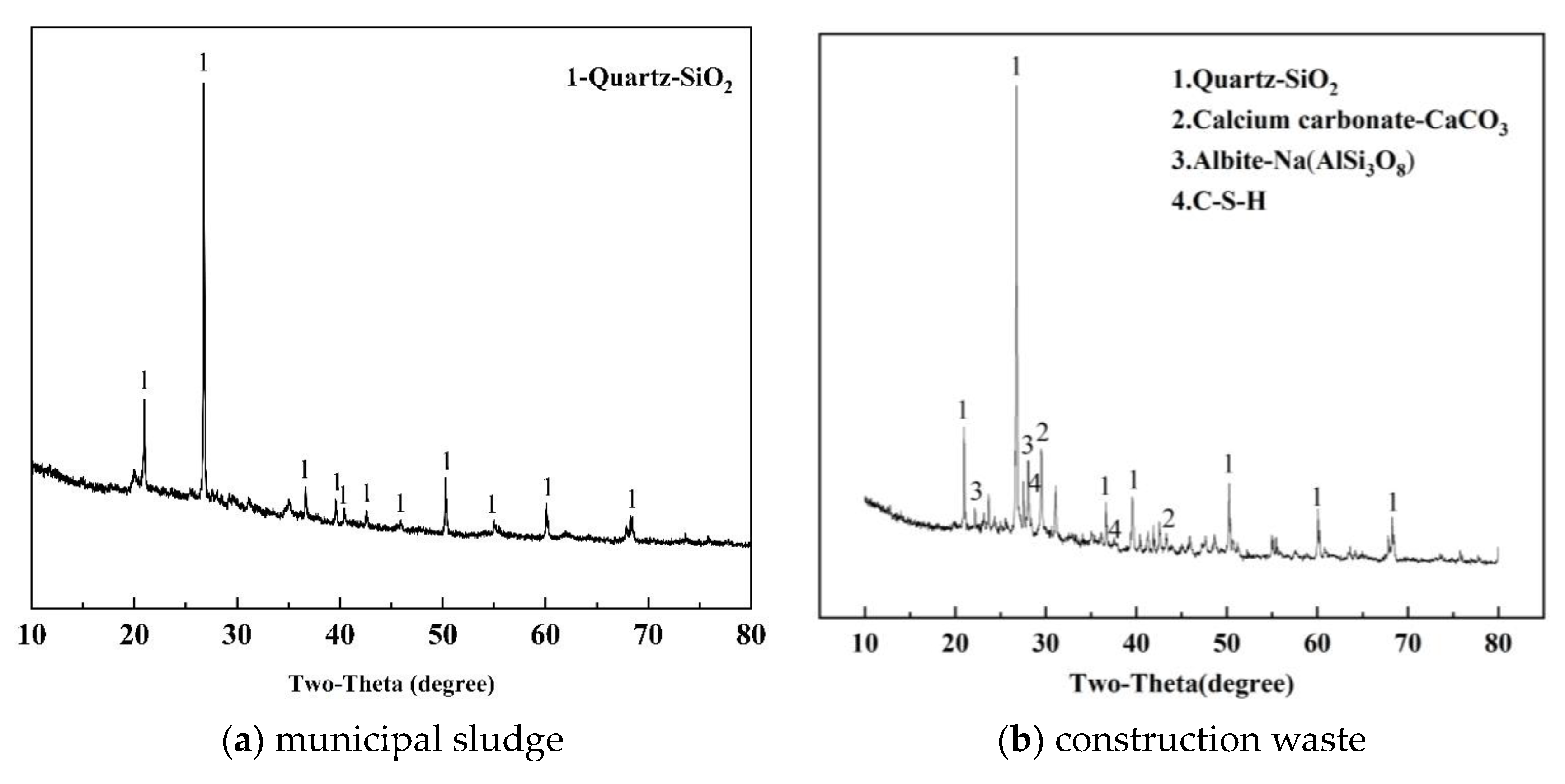
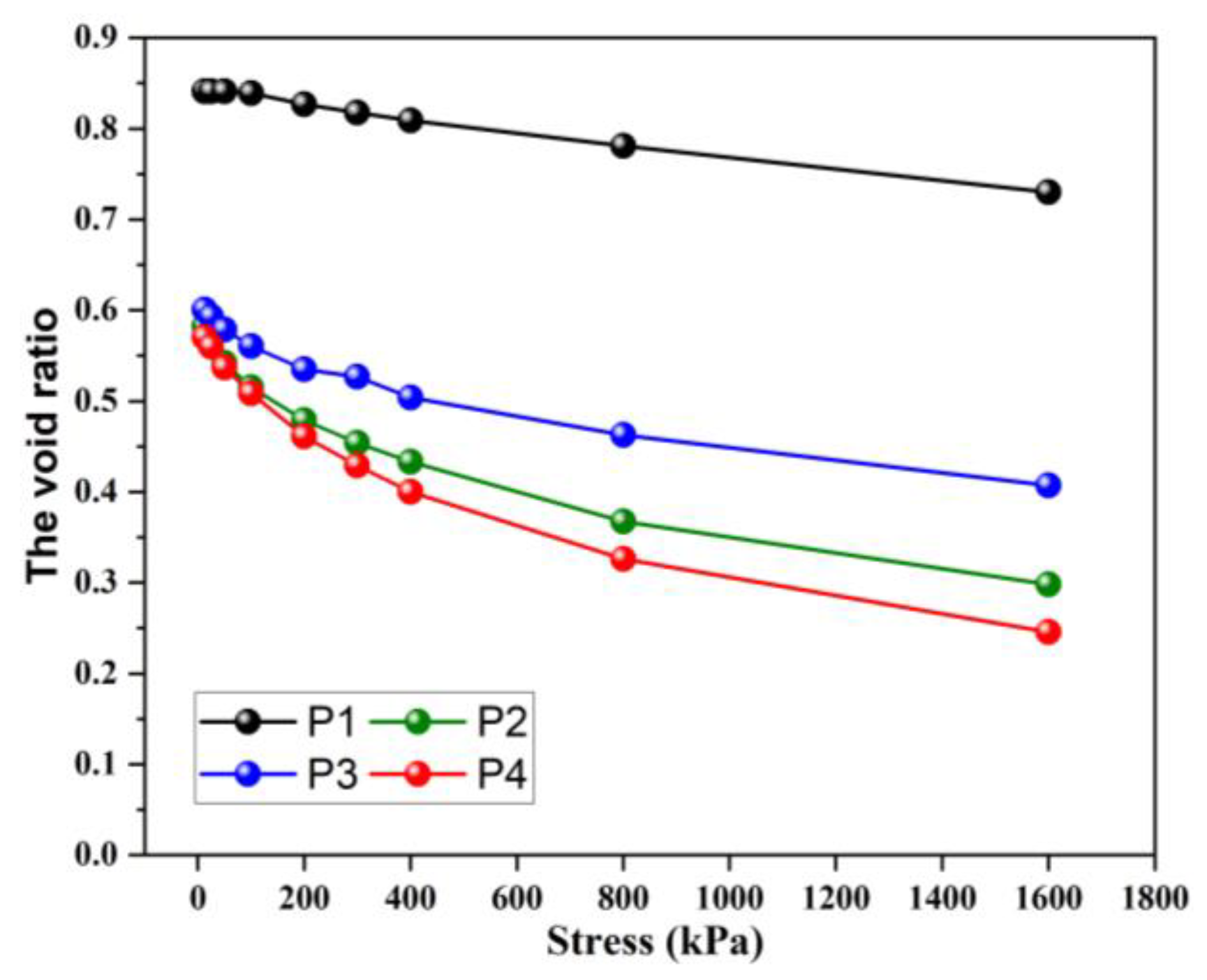

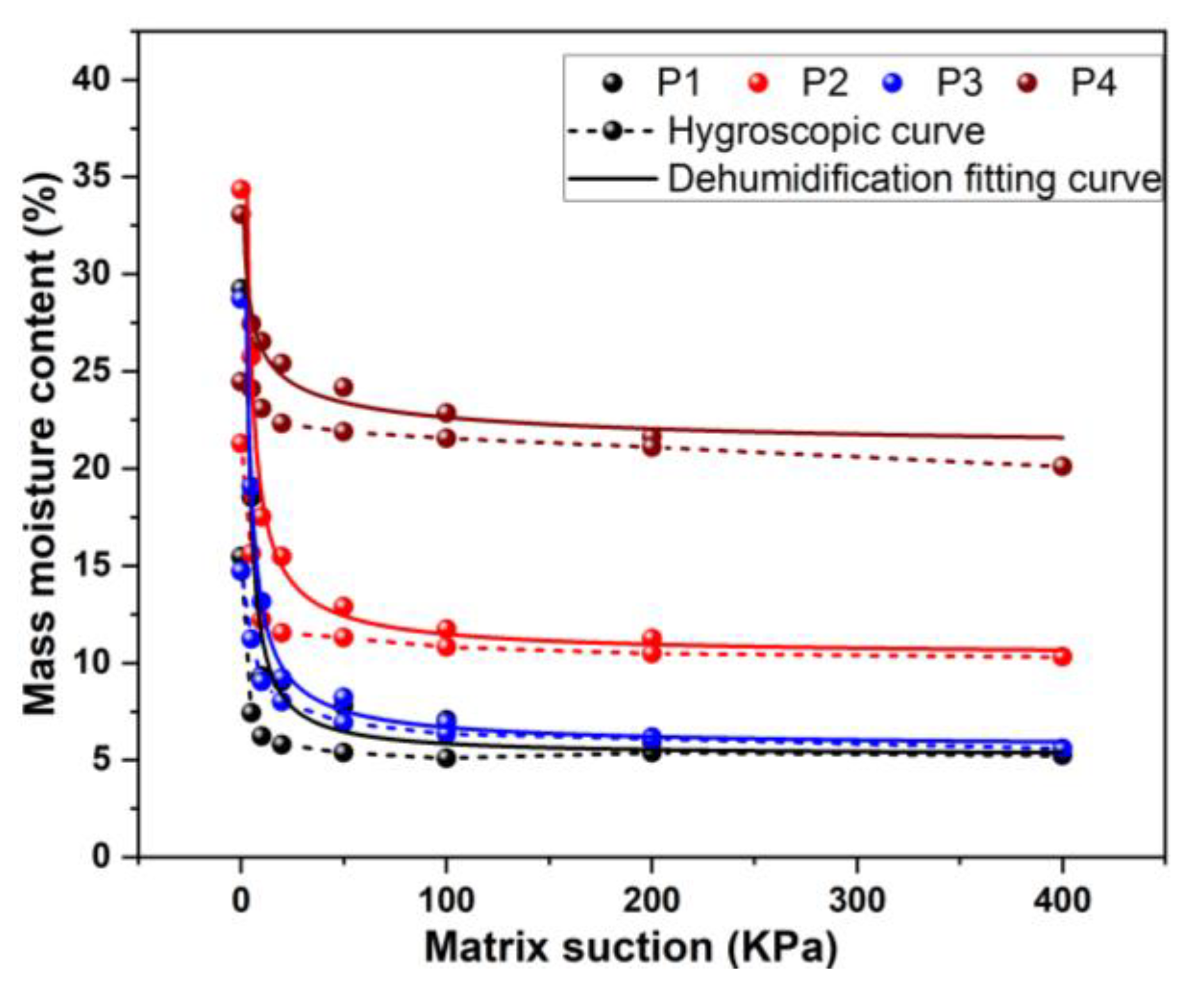

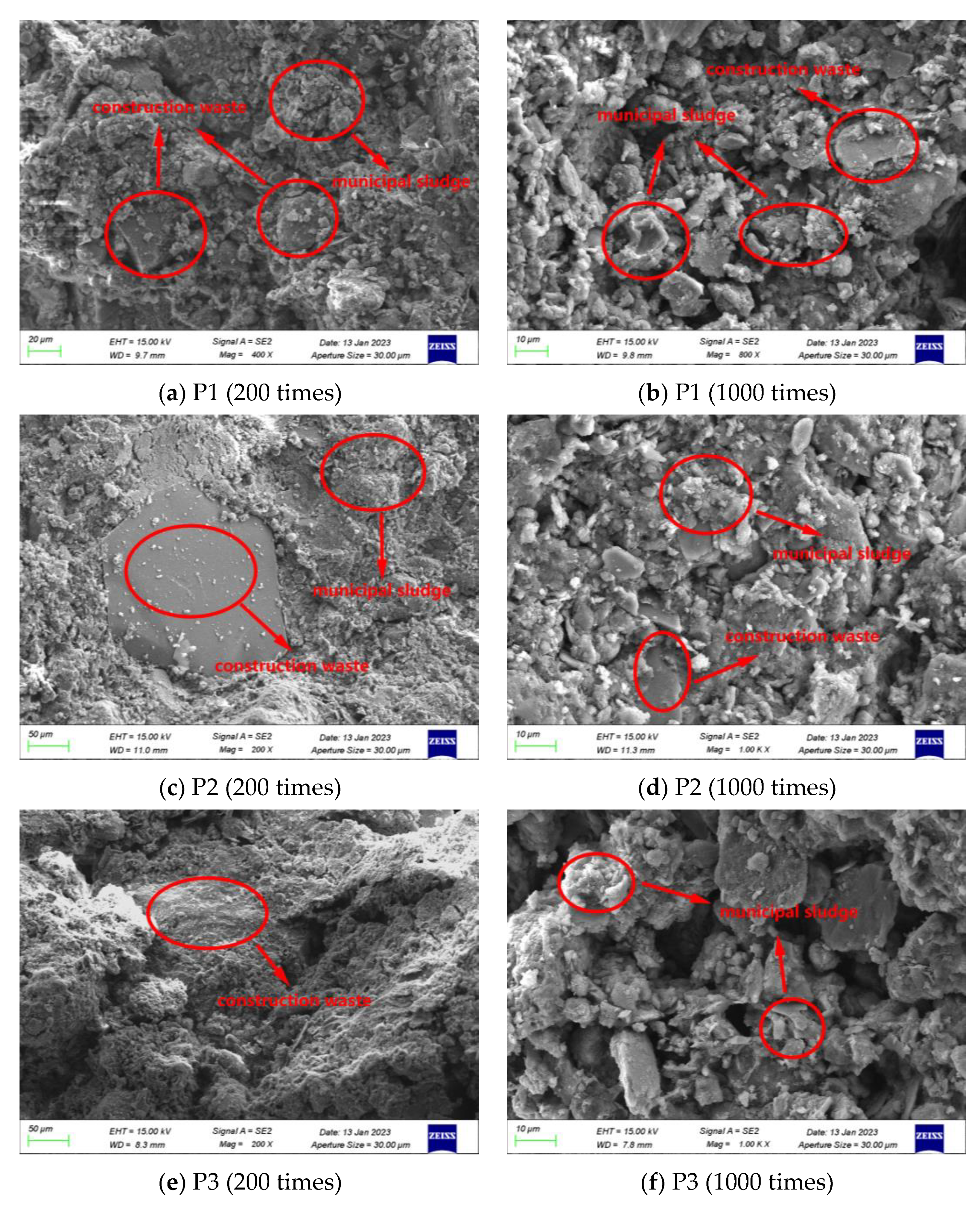
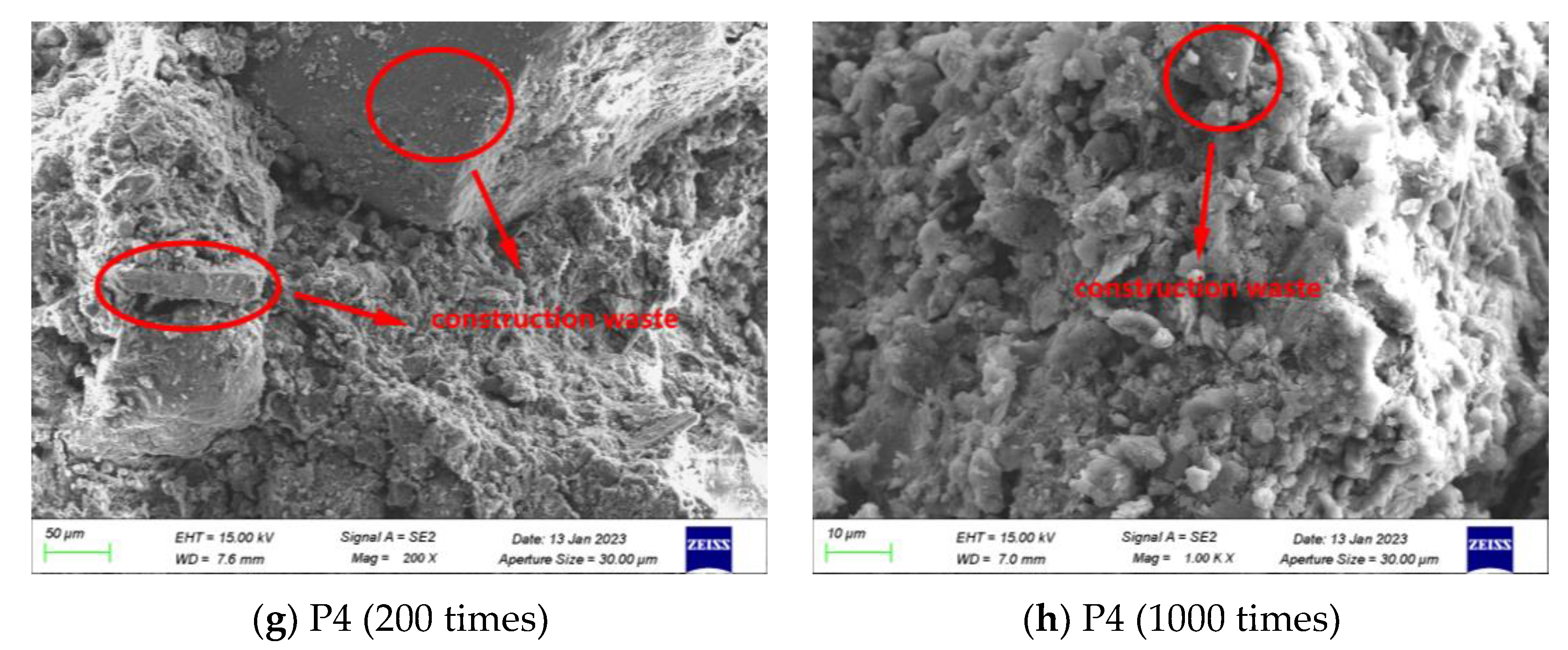
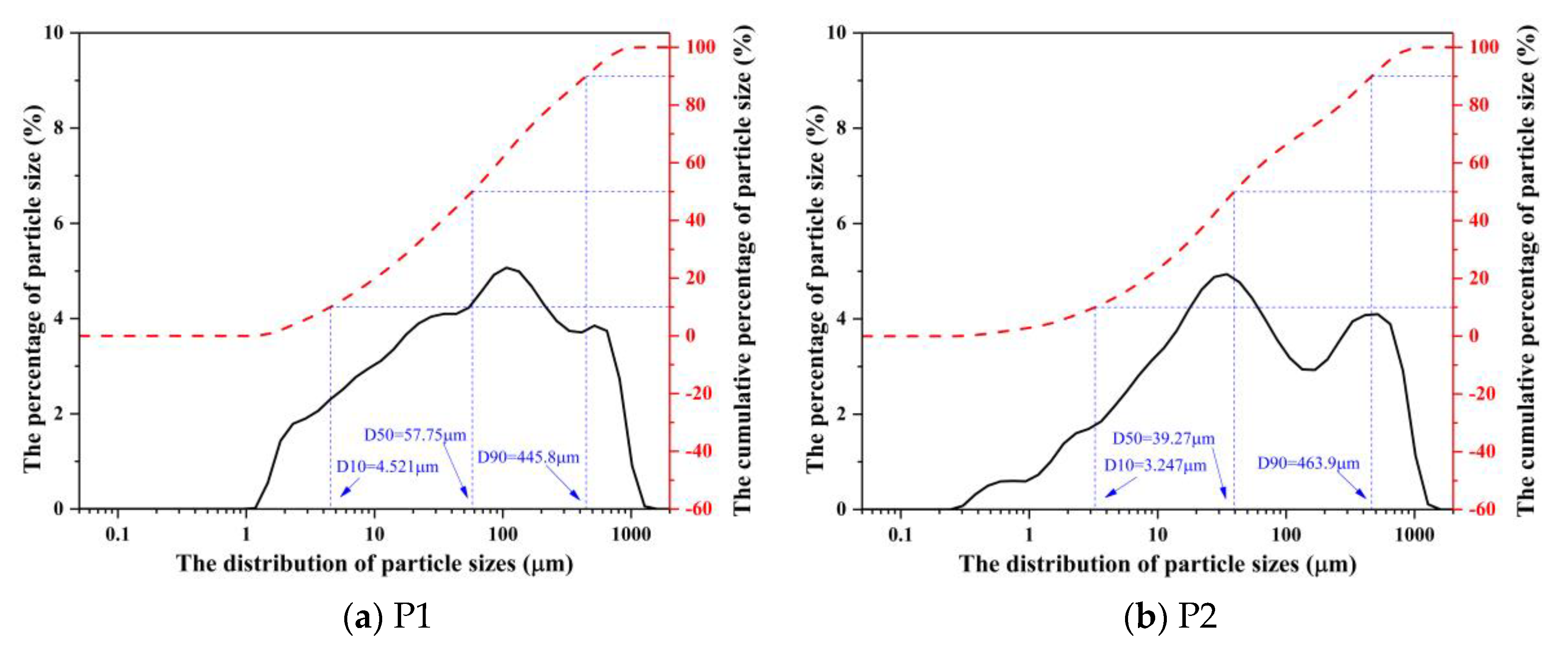


| Name of Raw Materials | SiO2 | Al2O3 | P2O5 | Fe2O3 | CaO | SO3 | MgO | K2O | TiO2 | Na2O | Others |
|---|---|---|---|---|---|---|---|---|---|---|---|
| Municipal sludge (%) | 37.19 | 17.19 | 14.65 | 10.87 | 6.62 | 4.09 | 3.25 | 3.00 | 1.11 | 0.61 | 1.42 |
| Construction waste (%) | 39.87 | 8.93 | 0.17 | 6.03 | 35.07 | 3.09 | 2.01 | 2.31 | 0.76 | 1.03 | 0.73 |
| Sample | P1 | P2 | P3 | P4 |
|---|---|---|---|---|
| MS:CW:CB | 30:60:7 | 35:40:5 | 40:70:5 | 45:40:9 |
| Model Parameters | P1 | P2 | P3 | P4 |
|---|---|---|---|---|
| a | 2.631 | 2.887 | 2.612 | 1.389 |
| b | 24.193 | 44.915 | 44.753 | 30.252 |
| c | 0.042 | 0.019 | 0.019 | 0.013 |
| R2 | 0.978 | 0.995 | 0.998 | 0.960 |
| Volumetric Mean Particle Size (µm) | Surface Mean Particle Size (µm) | Specific Surface Area (m2/g) | D10 (µm) | D50 (µm) | D90 (µm) | |
|---|---|---|---|---|---|---|
| P1 | 126.5 | 12.23 | 435.0 | 4.521 | 57.75 | 445.8 |
| P2 | 124.5 | 6.71 | 749.1 | 3.247 | 39.27 | 463.9 |
| P3 | 118.9 | 5.76 | 924.8 | 2.741 | 38.33 | 441.4 |
| P4 | 35.01 | 4.71 | 1129 | 2.304 | 21.94 | 94.73 |
| Rate of Change of Porosity from Initial to 1600 kpa (%) | Cohesive Force (kPa) | Internal Friction Angles (°) | Permeability Coefficient (cm/s) | |
|---|---|---|---|---|
| P1 | 13.20 | 100 | 30.11 | 5.04 × 10−6 |
| P2 | 52.71 | 70 | 24.23 | 7.34 × 10−5 |
| P3 | 34.88 | 150 | 26.10 | 6.4 × 10−5 |
| P4 | 58.40 | 50 | 31.00 | 5.74 × 10−5 |
Disclaimer/Publisher’s Note: The statements, opinions and data contained in all publications are solely those of the individual author(s) and contributor(s) and not of MDPI and/or the editor(s). MDPI and/or the editor(s) disclaim responsibility for any injury to people or property resulting from any ideas, methods, instructions or products referred to in the content. |
© 2024 by the authors. Licensee MDPI, Basel, Switzerland. This article is an open access article distributed under the terms and conditions of the Creative Commons Attribution (CC BY) license (https://creativecommons.org/licenses/by/4.0/).
Share and Cite
He, Y.; Lu, H.; Lan, J.; Ma, J.; Liu, M.; Dong, Y. Macroscopic Mechanical Properties and Microstructure Characteristics of Solid Waste Base Capillary Retarded Field Covering Material. Buildings 2024, 14, 313. https://doi.org/10.3390/buildings14020313
He Y, Lu H, Lan J, Ma J, Liu M, Dong Y. Macroscopic Mechanical Properties and Microstructure Characteristics of Solid Waste Base Capillary Retarded Field Covering Material. Buildings. 2024; 14(2):313. https://doi.org/10.3390/buildings14020313
Chicago/Turabian StyleHe, Yifan, Haijun Lu, Jirong Lan, Jiayu Ma, Mengyi Liu, and Yiqie Dong. 2024. "Macroscopic Mechanical Properties and Microstructure Characteristics of Solid Waste Base Capillary Retarded Field Covering Material" Buildings 14, no. 2: 313. https://doi.org/10.3390/buildings14020313




